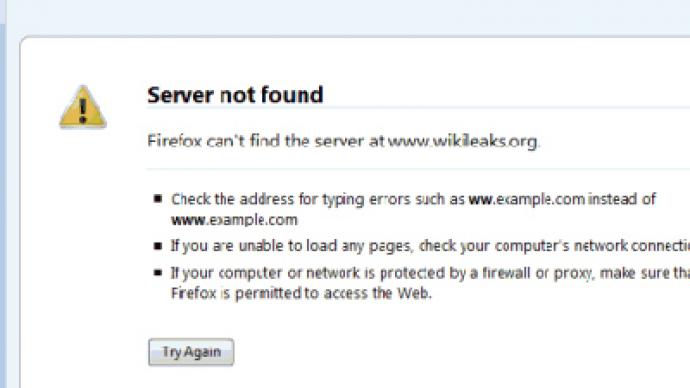Whistleblower site WikiLeaks says it is enduring a week-long attack on its sites, which is rendering them sluggish or inaccessible.
A distributed denial-of-service (DDoS) attack overwhelms a website with bogus requests from thousands of different internet addresses, compromising its ability to reply to legitimate users. The group has been enduring a DDoS since around the beginning of August, and it is intensifying, WikiLeaks said on Saturday. It amounts to up to 10 gigabits per second of traffic the group has to deal with. The attack targets both the main site of WikiLeaks and its mirror sites.AP cites Josh Corman from online content delivery company Akamai as characterizing the attack as "a bit larger" than attacks commonly seen in the past few years.Earlier, a group calling itself AntiLeaks claimed responsibility for targeting WikiLeaks. They called Julian Assange “a new breed of terrorist” and said they launch the attack in response to his attempt to seek asylum in Ecuador.The previously-unheard-of group may be claiming responsibility for actions they are not doing.Ecuador said it was going to make a decision on Assange’s asylum request shortly after the London Olympic Games.The attack coincided with WikiLeaks’ release of a new portion of emails allegedly acquired by the hacktivist group Anonymous from the server of consulting firm Stratfor. The batch concerns the supposed existence of a US-based system called TrapWire, which allegedly collects images from surveillance cameras across America and uses them to track people for possible threats.Loz Kaye leader of Pirate Party UK, says both Antileaks and Wikileaks have been making contradictory statements, with the former claiming sole responsibility for the attacks and the latter inferring US involvement. “It’s difficult to assess the truth in any of the claims,” he told RT. "It would actually seem unlikely that a group like Antileaks, a new group, would be able to mount such a sustained attack, but nevertheless it’s not impossible. It is possible to do this with fewer than 1,000 machines, but that would take some money, or organization behind it.” In any case, Kaye said that a concerted attempt to interfere with the work of the whistleblowing website was clearly visible. “This comes at a time when Wikileaks is exposing the latest group of leaks from the Stratfor mails,” he also noted. “This particularly focuses on the advanced surveillance system TrapWire.”



